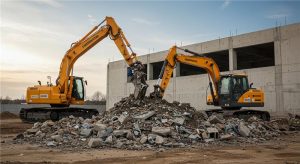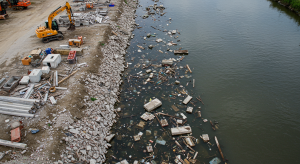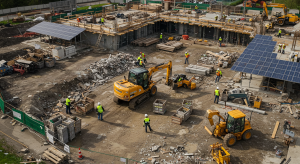Construction waste is the leftover materials that are not wanted in building, change of usage, and teardown works. These wastes can be composed of various materials, including concrete, wood, metals, bricks, foam, and even hazardous substances such as asbestos and lead-based paint. The problem with the environment is that a big part of the waste coming from these activities is non-biodegradable, and the way they are released into the atmosphere may affect the quality of air, water, and soil.
Construction waste leads to environmental compromise in many ways, such as land, air, and water pollution, and resource depletion. Besides that, the emission of GHG and the public health and biodiversity jeopardization are other negative impacts of construction waste on the environment.
Types of Construction Waste
Construction wastes have many differences and can be divided into several major classes: materials from plants and animals like wood and other similar materials, already known nonmetallic materials like concrete, glass, and metals, and lastly, the group of hazardous materials used in manufacturing and household, such as chemicals, paints, and asbestos. Every kind of waste needs very specific treatment to lessen the risk of pollution.
The trend toward the adoption of Construction Estimating Services has supported numerous projects in their quest to reduce waste levels through accurate prediction of material requirements, successful prevention of the excessive ordering of materials, and proper handling of leftover disposal. The stage of waste reduction in planning is crucial for the environment to have fewer adverse impacts.
Scale of the Construction Waste Problem

Globally, the construction industry generates billions of tons of waste annually. In rapidly developing cities, construction and demolition (C&D) waste can account for up to 40% of total solid waste. Urbanization, infrastructure expansion, and short building lifespans have all contributed to this surge in waste generation.
| Region | Estimated Annual C&D Waste (Million Tons) | Main Waste Components |
| North America | 350 | Concrete, wood, metals |
| Europe | 820 | Bricks, asphalt, concrete |
| Asia | 1,200+ | Concrete, steel, timber |
| Africa | 100+ | Bricks, concrete, wood |
Landfill Overload and Land Use Issues
When construction waste gets thrown into landfills, the space that is still available is taken up quite fast. Lots of countries are already dealing with limited landfills, which results in the need to start new landfills in areas previously untouched or used for farming. The adverse effects of this practice on the environment seem evident, but it also impacts the availability of land for food production.
Soil Contamination
Working with products containing lead-based paint, the use of solvents and adhesives is just one of the few examples of construction materials that might come with chemicals that will eventually end up in the soil. Slowly, these pollutants will build up in the soil, causing it to lose its fertility. Eventually, the soil might become so contaminated that it would be unfit for both animals and plants to survive on it.
Water Pollution from Construction Waste

Poorly managed waste is usually found in open areas, and as a result, rainwater can carry it to lakes, rivers, and other bodies of water. The most common pollutants in water sources are oil, heavy metals, and tiny particles of demolition material. These will not only make water bodies unfit for the living organisms inside them but will further contaminate our drinking water reservoirs.
Air Pollution and Dust Emissions
Demolition causes harmful particulate matter to the atmosphere, which in turn may cause many types of respiratory ailments in the people living nearby. Hazardous materials, when they are dismantled, may produce toxic dust or gases. High population combined with urban construction exacerbates this problem to a large degree.
Contribution to Climate Change
When waste breaks down in landfills, it gives off methane, a very potent greenhouse gas. Besides that, the process of making the new materials that are going to replace the ones that were thrown away causes a lot of carbon dioxide emissions, which contribute to the global climate crisis.
Loss of Natural Resources
Just imagine each time building waste that could have been recycled is thrown away. It is equivalent to the loss of natural materials such as wood, metal, and stone. The whole process of extracting and refining these resources to be used again will require energy and will have an impact on ecosystems. This means that the cycle of waste will continue.
Habitat Destruction and Biodiversity Loss
Waste disposal sites are frequently built on removed or cleared areas that have been directly removed from the list of living things that these waste sites will be displacing. Besides that, animals that come across construction debris get injured or even poisoned.
Visual Pollution and Urban Aesthetics
Rubbish heaps and scattered debris are among the things that lead to the degradation of the appearance of cities, towns, and rural areas. Apart from community pride, this can also be a factor in deterring tourists and lowering the value of the properties in the neighborhood.
Public Health Risks
Construction waste often contains harmful materials that can cause health problems to workers and residents. For example, the inhalation of dust from cement or asbestos can lead to respiratory diseases of a long-term nature, whereas direct contact with certain chemicals may cause skin and eye irritation.
Economic Impacts of Construction Waste
Improper waste management leads to higher disposal fees, cleanup costs, and lost opportunities for recycling revenue. As a result, cities are often required to use a large portion of the budget to clean up the money that could be used for other public services instead.
Regulatory and Legal Concerns
Countries, in general, have many rules regarding the management of construction waste. For those who do not meet the set standards, the punishment can be a fine, a court case, or even the halting of the project. The correct documentation, handling, and disposal are the basic requirements for legal compliance.
Recycling and Waste Diversion Solutions
Waste from construction sites in the form of metals, concrete, and wood can be processed by recycling facilities to create new products. On-site waste separation can allow companies to reduce the volume of waste that they send to landfills significantly.
H3: Circular Economy in Construction
The circular economy model provides for the use of materials in the design of buildings that can easily be taken apart and reused; thus, no waste will be produced from the demolition of these buildings in the future.
Sustainable Construction Practices

One of the green building strategies is waste reduction, which is pursued at every stage. The activities that embody this principle include ordering the required quantity of materials, using products made from recycled materials, and building structures that last and can be used in a different way in the future.
H3: Designing for Deconstruction
Designing for deconstruction is the alternative to the traditional demolition, in which the materials that have been removed can be both economically and environmentally reused.
Case Studies on Construction Waste Impact
In Japan, the introduction of strict and detailed waste sorting regulations has led to a recycling rate of more than 90% for the materials of construction. On the other hand, San Francisco and other cities have adopted compulsory recycling schemes for C&D waste that have led to a significant decrease in the amount of waste diverted to landfills.
Conclusion
One of the effects of the development is the generation of waste from construction, which is an inevitable source of waste. However, through the use of responsible planning, proper waste handling, and friendly construction methods, the environmental impact of construction waste can be greatly reduced. The industry can be better with the use of better habits and tools without affecting the environment negatively.
FAQs on Construction Waste and the Environment
Q1: What is the most harmful type of construction waste for the environment?
A1: Hazardous waste like asbestos, lead-based paints, and chemical solvents pose the greatest risks due to their toxicity.
Q2: How can estimating services help reduce waste?
A2: They help predict accurate material needs, preventing over-ordering and reducing leftover materials that end up as waste.
Q3: Is all construction waste recyclable?
A3: No, but a large portion, such as concrete, metals, and wood, can be recycled with the right facilities and processes.
Q4: How does construction waste contribute to climate change?
A4: It releases greenhouse gases during decomposition and through the production of replacement materials.
Q5: What can individuals do to reduce construction waste?
A5: Support sustainable construction practices, choose recycled materials, and ensure contractors follow proper waste management.
To Read Visit: thedecorpost
